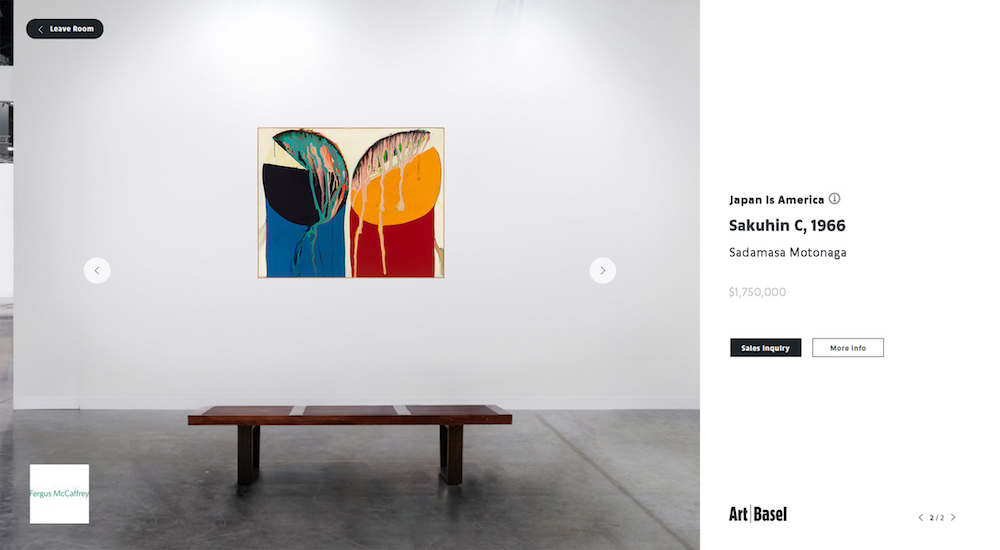
In the opening moments of Art Basel Hong Kong’s VIP preview of its online viewing rooms on Wednesday—the fair’s virtual solution to its canceled physical fair in the city—art dealer Iwan Wirth said he immediately received texts from clients complaining that they couldn’t access Hauser and Wirth’s viewing room via the fair website.
“That was my first interaction when I realized the website was live,” said Wirth. From his office in Somerset, England, he started returning calls and sending additional links, and “that’s when I saw we sold the Jenny Holzer.” The silver, wall-hung piece, XX 8 (2015–18), with an asking price of $350,000, went to a buyer from the Middle East. (Another work, by Paul McCarthy, sold to a buyer quarantined in France after testing positive for the virus.)
“Now, are these new collectors? No,” says Wirth. “We know them and they are seasoned collectors.” But he was still pleased with the results given that the gallery had no pre-sales, he says. Through both its own digital platforms and the Basel viewing rooms, the gallery also sold works by Josef Albers (for $600,000), Pipilotti Rist (for $140,000), and several pieces by Paul McCarthy. As of publication time, a US buyer had a hold on a major Philip Guston painting.
Responding to questions about the technical glitch, a representative for Art Basel told Artnet News: “As to be expected with a new digital initiative, we experienced some technological difficulties. In the first hour, the servers became overwhelmed by the number of users and the site went down briefly, (for 25 minutes). Thankfully, our technical teams were able to restore it quickly, and we’ve since received terrific feedback from both gallerists and collectors about their experience with the platform.”
Jenny Holzer, XX 8 (2015–18). Image courtesy of the artist and Hauser & Wirth.
Gagosian Gallery also reported robust sales despite the less-than-ideal conditions. “On the one hand we sell art every day via JPEG so there is nothing particularly out of the ordinary and it’s why the shift to this medium has been inevitable,” said Gagosian director Sam Orlofsky. “That said, the social, political, and economic climate right now is what is uncertain. In the face of such a difficult environment, the fact that people are still willing to make such a large commitment has been a pleasant surprise.”
By Friday, the gallery reported six sales ranging from $260,000 to $1.3 million (€1.2 million). Georg Baselitz’s painting The other side of the oil stain (2019) went for €1.2 million, Mary Weatherford’s Splendor in the Grass (2019) for $750,000, Tetsuya Ishida’s Derelict Building Worker’s Chair (1996) for $500,000, Zeng Fanzhi’s Untitled (2019) for $450,000, Jennifer Guidi’s An Instance of Becoming (2019) for $300,000, and Jia Aili’s Youth and Ultramarine (2019) for $260,000.
Mary Weatherford, Splendor in the Grass (2019) ©️ Mary Weatherford. Photo: Fredrik Nilsen Studio. Courtesy Gagosian.
“While you never want to extrapolate from a few data points, it appears that China is getting back to business sooner. In other words, the places that were affected first with the virus and are now on the downside of the curve, may be returning to some semblance of business sooner,” Orlofsky said. “A lot of our purchasers were from the Far East.”
David Zwirner Gallery’s early preview sales included paintings by Mamma Andersson for $400,000, Lucas Arruda for $100,000, Marlene Dumas for $2.6 million, Luc Tuymans for $2 million, Noah Davis for $360,000, and Liu Ye for $500,000. The gallery said that the inquiries on opening day broke down to: 23 percent from the United States, 46 percent from Asia, and 31 percent from Europe.
But while mega-galleries, like Hauser & Wirth, David Zwirner, and Gagosian are so far reporting relatively robust sales at high prices in the online viewing rooms, feedback from smaller and mid-size galleries has been more quiet. Some sources told Artnet News that gallery owners with their own digital platforms such as theirs were better placed to handle the fair’s opening and make sales amid the website’s problems.
“We’ve received very strong feedback from our exhibitors; many small and mid-sized galleries have been using our platform as an opportunity to explore the concept of an online viewing room and to connect with new potential buyers, while larger blue-chip galleries have benefited by cross-promoting their own digital platforms,” said Art Basel director Marc Spiegler in a statement. “And while nothing can replace the experience of visiting an art fair in person, our VIPs across the globe were also excited to view more than 2,000 exceptional artworks in one digital space.”
San Francisco’s Jessica Silverman Gallery sold two paintings and two sculptures by Woody De Othello, priced between $14,000 and $18,000. “We haven’t had any technical glitches with the online viewing room, although the internet has been sluggish due to the sheer volume of people working online from home,” Silverman said.
“At this difficult moment, when the physical and economic health of the entire world is under threat, I am grateful for the opportunity of a platform constructed and endorsed by Art Basel,” Silverman said. “We are working hard to keep our artists’ studios afloat by offering collectors works that keep things in perspective and remind them of the human big picture.”